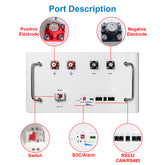Understanding How Golf Cart Batteries Differ from Regular Car Batteries
When it comes to vehicles, most people are familiar with car batteries, but what about golf cart batteries? Though both types of batteries serve the essential function of powering their respective vehicles, the differences between golf cart batteries and regular car batteries are significant. Understanding how golf cart batteries differ from regular car batteries is key to maintaining their performance and ensuring longevity.
- What Makes Golf Cart Batteries Different from Regular Car Batteries?
- Why Do Golf Cart Batteries Differ from Regular Car Batteries in Construction?
- How Charging Systems Are Different for Golf Cart and Car Batteries
- Performance Differences: How Do Golf Cart Batteries Differ from Regular Car Batteries?
- How Maintenance Differs Between Golf Cart Batteries and Car Batteries
- Cost Differences: How Do Golf Cart Batteries Differ from Regular Car Batteries in Terms of Price?
- Understanding How Golf Cart Batteries Differ from Regular Car Batteries
In this article, we will explore the different characteristics, designs, and applications of both types of batteries. From voltage and capacity to construction and maintenance, we’ll cover everything you need to know to understand how golf cart batteries differ from regular car batteries. Let’s dive deeper into these differences and why they matter.
What Makes Golf Cart Batteries Different from Regular Car Batteries?
Golf cart batteries and regular car batteries are designed to serve two very different purposes. While both are used to provide power to vehicles, their specifications and usage patterns vary significantly. The first and most obvious difference between these two types of batteries is their voltage and capacity.
Voltage and Capacity Differences
Regular car batteries typically operate at 12 volts, which is suitable for starting the car engine and providing power to various electrical components. These batteries are designed to supply a quick burst of power to start the engine and then rely on the car’s alternator to maintain a charge.
On the other hand, golf cart batteries usually operate at 6 volts, 8 volts, or 12 volts, depending on the model and manufacturer. These batteries need to provide consistent power over extended periods, often in a continuous discharge, unlike car batteries that only deliver power in short bursts. Because golf carts need a sustained energy output to move over long distances, golf cart batteries generally have a larger capacity and higher amp-hour (Ah) ratings than regular car batteries.
Deep-Cycle vs. Starter Batteries
Another significant distinction is in the type of battery used. Regular car batteries are primarily starter batteries, meaning they are designed for short, high-current bursts of power. They are built to start the car engine and supply power to the vehicle’s electrical systems briefly. However, they are not intended for prolonged use under load.
Golf cart batteries, on the other hand, are deep-cycle batteries. These are designed to discharge over a longer period and recharge without significantly degrading. Golf cart batteries are engineered to handle deep discharges and recharges, making them perfect for vehicles that require sustained energy, like electric golf carts. This difference in design plays a crucial role in how the two types of batteries perform and their longevity.
>>See also How Long Will A 24 Volt Battery Power A Leaf Blower
Why Do Golf Cart Batteries Differ from Regular Car Batteries in Construction?
The construction of golf cart batteries differs from regular car batteries due to their intended use. Understanding these differences can help you make better choices when it comes to purchasing, maintaining, and replacing batteries for your vehicles.
Material Differences and Design
Most regular car batteries are made using flooded lead-acid technology. These batteries have liquid electrolytes that are prone to spillage, which is why they are typically installed in an upright position in the vehicle. These batteries are also designed to be recharged continuously during regular vehicle operation.
Golf cart batteries, on the other hand, are often built using sealed lead-acid (SLA) or gel-cell technology. These types of batteries are less prone to leakage and are designed to be maintenance-free. In addition, they are engineered to handle deep cycling, meaning that they can discharge fully and recharge many times without deteriorating. This makes them ideal for applications where constant, sustained power is required over extended periods, like in golf carts.
How Charging Systems Are Different for Golf Cart and Car Batteries
One of the key differences between golf cart batteries and regular car batteries lies in the charging systems they use. Understanding these systems is essential to knowing how to maintain and extend the lifespan of these batteries.
The Charging Cycle for Golf Cart Batteries
Golf cart batteries typically undergo deeper discharge cycles than regular car batteries. Because golf carts require power over extended periods, their batteries are designed to handle these long, slow discharges. As a result, they need to be recharged properly to avoid overcharging or undercharging, both of which can significantly shorten the battery's lifespan.
Golf cart battery chargers are specialized to ensure that the battery is charged at an optimal rate. These chargers usually provide a lower, steadier charge to preserve the battery’s capacity. Most modern golf cart chargers are smart chargers, meaning they automatically stop charging when the battery is full to prevent damage from overcharging.
Car Battery Charging and Alternator Systems
In contrast, regular car batteries rely heavily on the alternator for charging. The alternator generates electricity while the engine is running, and this electricity is used to keep the car battery charged. Unlike golf cart batteries, car batteries do not typically go through full discharge cycles. Instead, they only need to provide power when starting the engine and running the electrical systems, with the alternator continuously recharging the battery as needed.
Since car batteries are not used for prolonged power delivery like golf cart batteries, the charging cycle is much less critical. The car’s alternator will top off the battery with the power it generates, ensuring that it is always ready for the next use.
Performance Differences: How Do Golf Cart Batteries Differ from Regular Car Batteries?
The performance of golf cart batteries differs from regular car batteries in several key ways. These differences affect not only the operational efficiency of the vehicles but also the cost and maintenance required for each battery type.
Longevity and Cycle Life
One of the most significant differences between golf cart batteries and regular car batteries is their longevity. Golf cart batteries are built to last longer due to their deep-cycle design. With proper care, a golf cart battery can last between 4 to 7 years, depending on usage, charging habits, and environmental factors.
In comparison, regular car batteries have a shorter lifespan, usually lasting between 3 to 5 years. They are designed for different purposes, with less emphasis on extended deep cycling, meaning they do not last as long as golf cart batteries under normal usage.
Power Output for Prolonged Use
Golf cart batteries are specifically designed to deliver power for longer periods. Whether you're cruising around a golf course or driving an electric vehicle (EV), golf cart batteries provide consistent energy for sustained periods. This allows golf carts to travel long distances without needing to recharge constantly.
Car batteries, on the other hand, are built to provide quick bursts of power to start the engine. Once the engine is running, the car’s alternator takes over, providing continuous power for the electrical components. Car batteries are not designed to discharge over long periods, making them unsuitable for applications like golf carts that require prolonged energy output.
How Maintenance Differs Between Golf Cart Batteries and Car Batteries
Maintaining golf cart batteries and regular car batteries requires different approaches to ensure their longevity and efficiency.
Regular Maintenance for Golf Cart Batteries
Golf cart batteries, particularly those made from lead-acid technology, require regular maintenance to keep them in optimal condition. This may involve checking the water levels in the cells, cleaning terminals to prevent corrosion, and ensuring that the battery is charged properly. Regular maintenance can significantly extend the life of your golf cart battery and help avoid unexpected failures.
Car Battery Maintenance
Car batteries typically require less hands-on maintenance. Most modern car batteries are maintenance-free, meaning they do not require topping up with water or frequent cleaning. However, it’s still important to regularly check the battery’s charge level and look for signs of corrosion around the terminals. In extreme temperatures, it’s also wise to check that the battery is functioning properly before embarking on a long trip.
>>See also Understanding The Charging And Usage Of A 300Ah Battery
Cost Differences: How Do Golf Cart Batteries Differ from Regular Car Batteries in Terms of Price?
While both golf cart batteries and regular car batteries can be an investment, the cost of golf cart batteries tends to be higher. Let’s compare the price differences.
Initial Cost of Golf Cart Batteries vs Car Batteries
A single golf cart battery typically costs between $100 to $300 depending on its voltage and capacity. However, since golf carts often use multiple batteries in a series, the total cost for replacing a full set of batteries can range from $600 to $2,000.
Regular car batteries, on the other hand, are much cheaper. The price of a standard car battery ranges from $50 to $150, and since most cars only require one battery, the initial cost is significantly lower.
Long-Term Investment and Durability
Although the upfront cost of golf cart batteries is higher, they tend to last much longer than car batteries, making them a more cost-effective choice over time. If properly maintained, golf cart batteries can last between 4 to 7 years, while regular car batteries generally last only 3 to 5 years. This longer lifespan reduces the need for frequent replacements, making golf cart batteries a better long-term investment.
Understanding How Golf Cart Batteries Differ from Regular Car Batteries
In conclusion, the differences between golf cart batteries and regular car batteries are evident in several areas, from voltage and capacity to construction, performance, and charging systems. Golf cart batteries are designed to provide sustained power over long periods, making them ideal for electric vehicles like golf carts. Regular car batteries, on the other hand, are designed for short bursts of power to start the engine and support the car’s electrical components.



















Leave a comment
All blog comments are checked prior to publishing